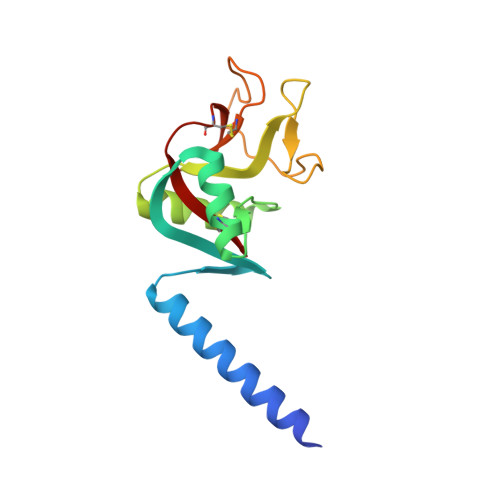Crystallographic complexes of surfactant protein A and carbohydrates reveal ligand-induced conformational change.
Shang, F., Rynkiewicz, M.J., McCormack, F.X., Wu, H., Cafarella, T.M., Head, J.F., Seaton, B.A.(2011) J Biol Chem 286: 757-765
- PubMed: 21047777
- DOI: https://doi.org/10.1074/jbc.M110.175265
- Primary Citation of Related Structures:
3PAK, 3PAQ, 3PAR, 3PBF - PubMed Abstract:
Surfactant protein A (SP-A), a C-type lectin, plays an important role in innate lung host defense against inhaled pathogens. Crystallographic SP-A·ligand complexes have not been reported to date, limiting available molecular information about SP-A interactions with microbial surface components. This study describes crystal structures of calcium-dependent complexes of the C-terminal neck and carbohydrate recognition domain of SP-A with d-mannose, D-α-methylmannose, and glycerol, which represent subdomains of glycans on pathogen surfaces. Comparison of these complexes with the unliganded SP-A neck and carbohydrate recognition domain revealed an unexpected ligand-associated conformational change in the loop region surrounding the lectin site, one not previously reported for the lectin homologs SP-D and mannan-binding lectin. The net result of the conformational change is that the SP-A lectin site and the surrounding loop region become more compact. The Glu-202 side chain of unliganded SP-A extends out into the solvent and away from the calcium ion; however, in the complexes, the Glu-202 side chain translocates 12.8 Å to bind the calcium. The availability of Glu-202, together with positional changes involving water molecules, creates a more favorable hydrogen bonding environment for carbohydrate ligands. The Lys-203 side chain reorients as well, extending outward into the solvent in the complexes, thereby opening up a small cation-friendly cavity occupied by a sodium ion. Binding of this cation brings the large loop, which forms one wall of the lectin site, and the adjacent small loop closer together. The ability to undergo conformational changes may help SP-A adapt to different ligand classes, including microbial glycolipids and surfactant lipids.
Organizational Affiliation:
Department of Physiology and Biophysics, Boston University School of Medicine, Boston, Massachusetts 02118, USA.
















